Perfect Basmati Rice: A Step-by-Step Guide
This post may contain affiliate links. Read my full disclosure policy.
Learn how to cook fragrant basmati rice to perfection—tender, fluffy, and just right for soaking up your favorite curries and more.
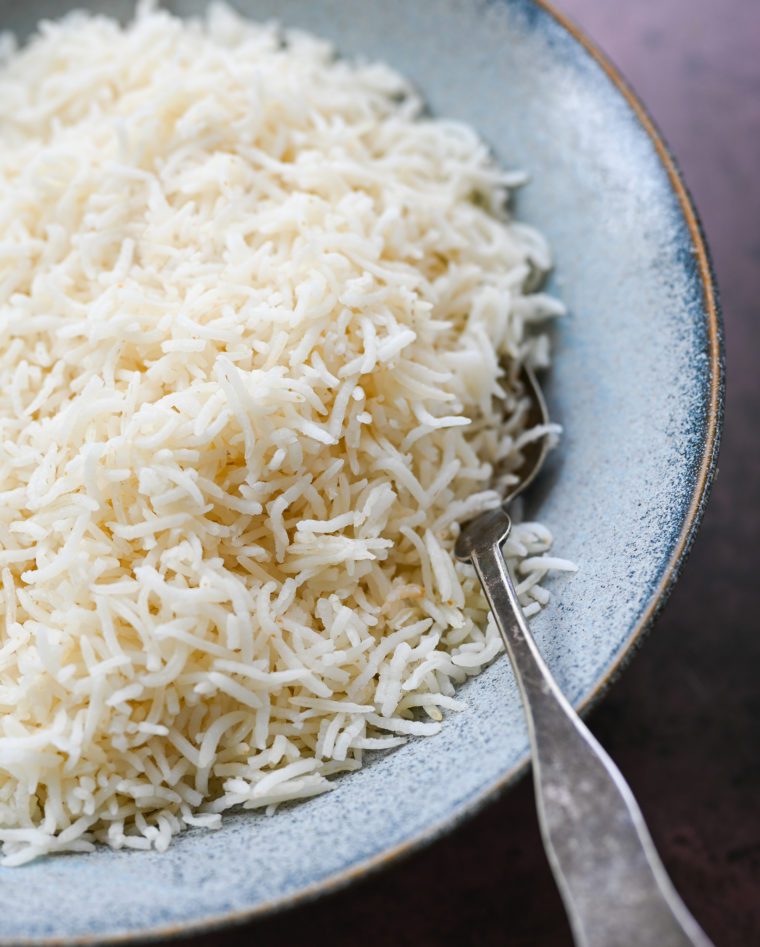
Basmati is a fragrant long grain rice grown in the Himalayas and Pakistan known for its nutty flavor. “Bas” in Hindi language means “aroma” and “mati” means “full of,” hence the word Basmati — or “full of aroma.” The key to making perfect basmati rice is to start with a high-quality brand of rice, preferably one imported from India or Pakistan. I love using Jyoti Basmati Supreme—it’s labeled “very long grain” and expands beautifully when cooked. It’s also important to rinse the rice under running water for a minute or two before cooking. This releases excess starch and prevents the grains from sticking together once cooked; the texture of basmati rice should be tender and fluffy, and the grains should be separate from one another.
Basmati rice makes a perfect side dish to many dishes, such as chicken curry, mulligatawny, butter chicken, chicken tikka masala, and tandoori chicken, to name just a few.
Table of Contents
“This truly is the perfect basmati rice! Tried and true, this recipe never fails…much better than the package directions!”
What You’ll Need To Make Basmati Rice
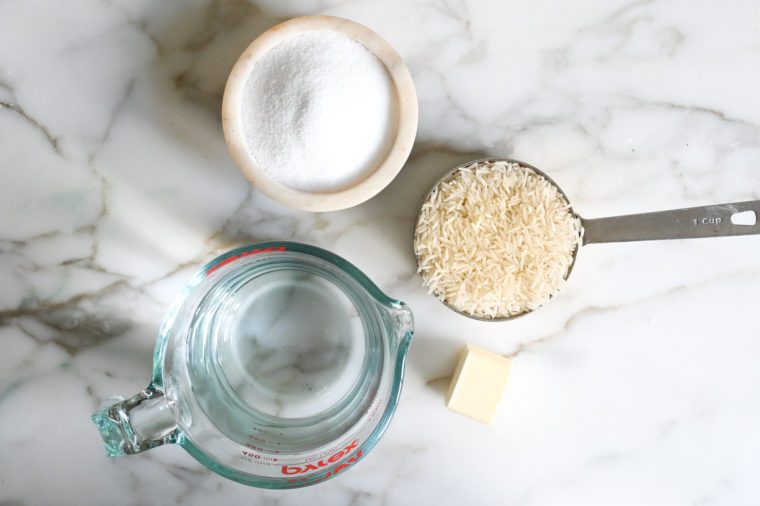
Step-by-Step Instructions
To cook basmati rice, begin by placing the rice in a fine mesh strainer. Place under cold running water, swishing the rice with your hand, for 1 to 2 minutes to release excess starch. (Alternatively, place the rice in a medium bowl and add enough water to cover by 2 inches. Using your hands, gently swish the grains to release any excess starch. Carefully pour off the water, leaving the rice in the bowl. Repeat four times, or until the water runs almost clear. Use a fine mesh strainer to drain the rice.)
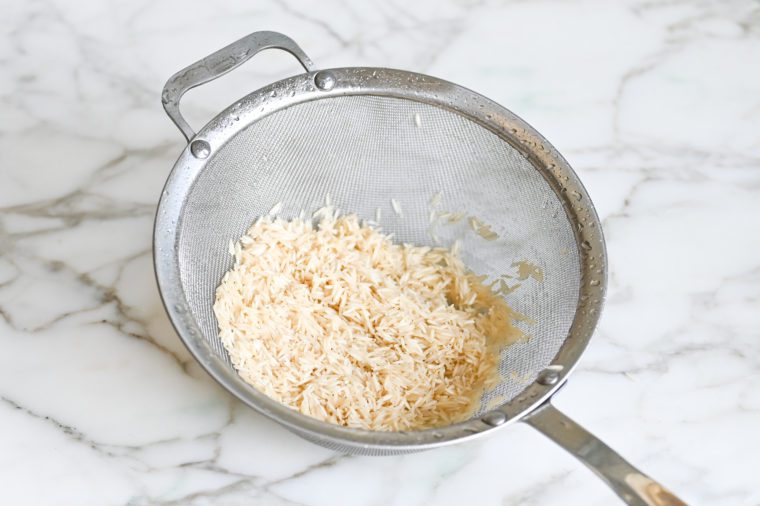
In a medium pot, combine the rice, water, butter, and salt. I use a ratio of 1 cup of rice to 1-3/4 cups of water.
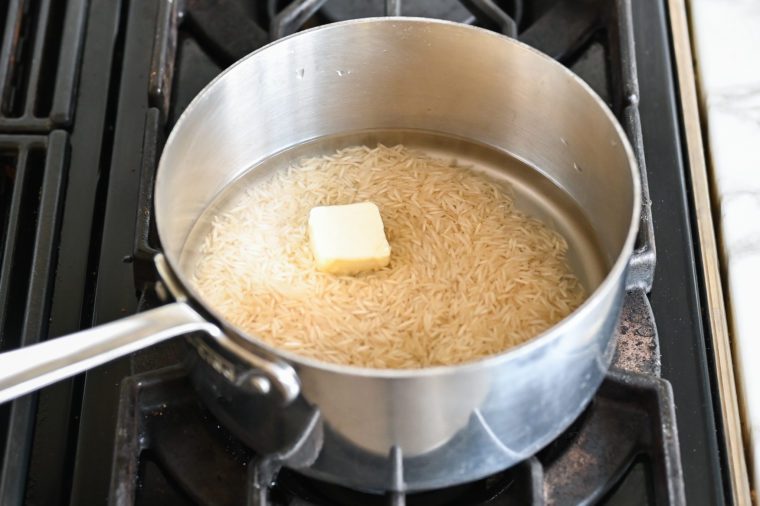
Bring to a boil.
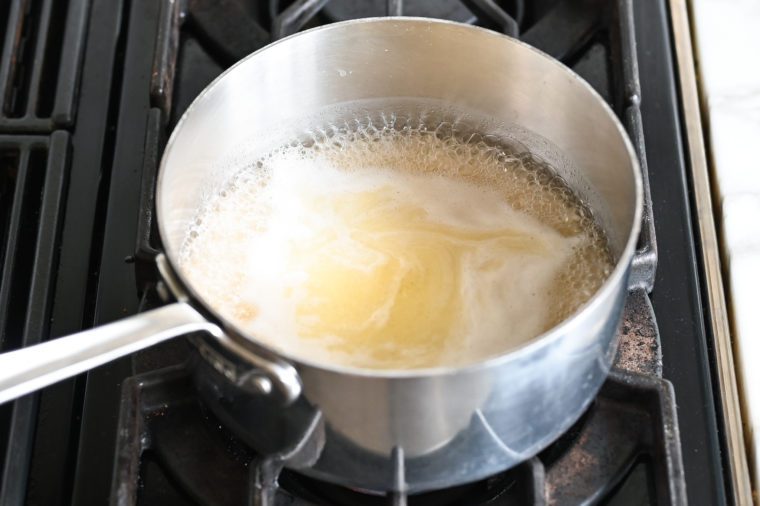
Cover the pot with a tight fitting lid and turn the heat down to a simmer.
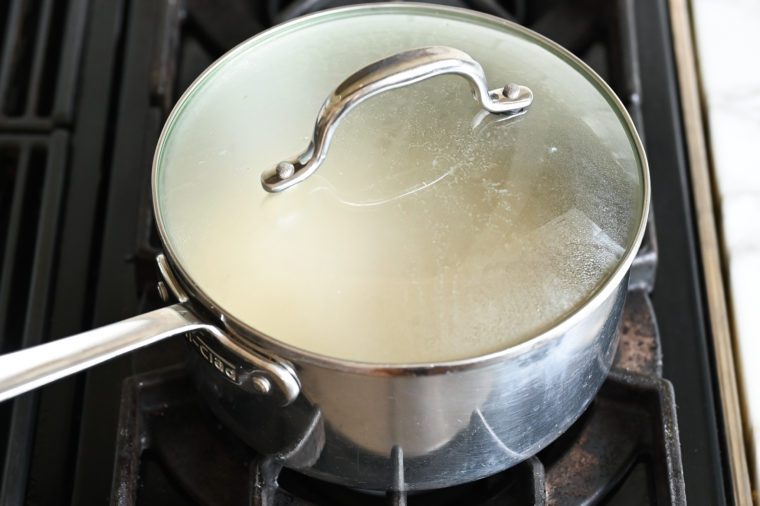
Cook for 15 to 20 minutes, until all of the water is absorbed and the rice is tender. If the rice is still too firm, add a few more tablespoons of water and continue cooking for a few minutes more.
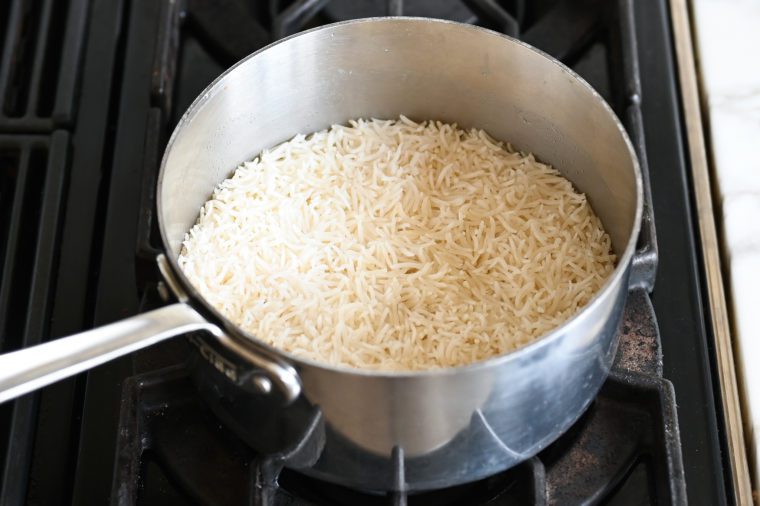
Remove the pan from the heat and allow it to sit covered for 5 minutes, then fluff the rice with a fork.
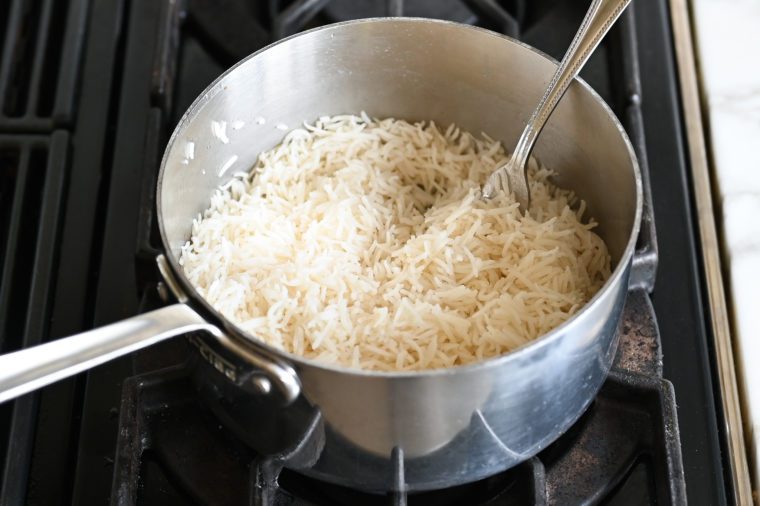
How To Store Basmati Rice
Store leftover basmati rice in an airtight container in the refrigerator for up to 4 days. To reheat it, place the rice in a microwave-safe bowl and add 1 to 2 tablespoons of water to help retain moisture. Cover the bowl with a damp paper towel or a microwave-safe lid. Microwave on high for 1 to 2 minutes, stirring halfway through to ensure even heating.
How To Freeze Basmati Rice
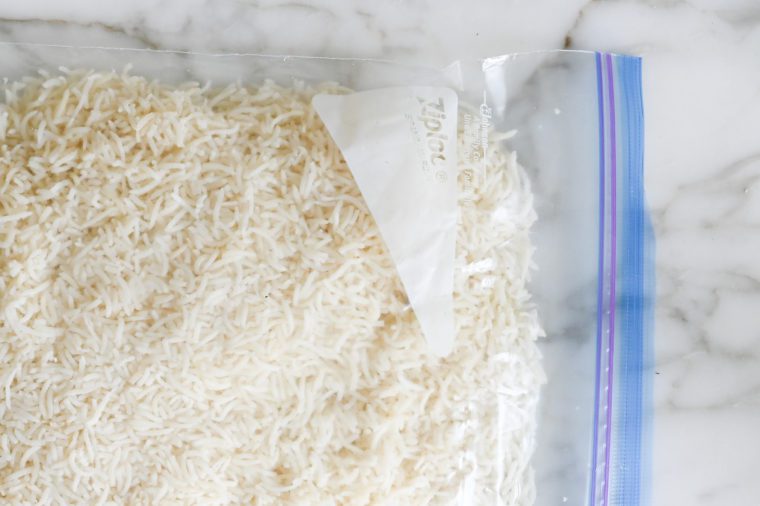
Basmati rice can be frozen in an airtight container for up to 3 months. For easier storage, flatten it out in sealable plastic bags to save space in the freezer. No need to thaw it before reheating—just remove it from the freezer and microwave with 1 to 2 tablespoons of water.

You May Also Like
Perfect Basmati Rice
Ingredients
- 1 cup basmati rice preferably imported from India or Pakistan
- 1¾ cups water
- 1½ tablespoons unsalted butter
- ½ teaspoon salt
Instructions
- Place the rice in a fine mesh strainer. Place under cold running water, swishing the rice with your hand, for 1 to 2 minutes to release excess starch. (Alternatively, place the rice in a medium bowl and add enough water to cover by 2 inches. Using your hands, gently swish the grains to release any excess starch. Carefully pour off the water, leaving the rice in the bowl. Repeat four times, or until the water runs almost clear. Use a fine mesh strainer to drain the rice.)
- In a medium pot, bring the rice, water, butter, and salt to a boil. Cover the pot with a tight fitting lid, then turn the heat down to a simmer and cook for 15 to 20 minutes, until all of the water is absorbed and the rice is tender. If the rice is still too firm, add a few more tablespoons of water and continue cooking for a few minutes more. Remove the pan from the heat and allow it to sit covered for 5 minutes. Fluff the rice with a fork and serve.
Notes
Nutrition Information
This website is written and produced for informational purposes only. I am not a certified nutritionist and the nutritional data on this site has not been evaluated or approved by a nutritionist or the Food and Drug Administration. Nutritional information is offered as a courtesy and should not be construed as a guarantee. The data is calculated through an online nutritional calculator, Edamam.com. Although I do my best to provide accurate nutritional information, these figures should be considered estimates only. Varying factors such as product types or brands purchased, natural fluctuations in fresh produce, and the way ingredients are processed change the effective nutritional information in any given recipe. Furthermore, different online calculators provide different results depending on their own nutrition fact sources and algorithms. To obtain the most accurate nutritional information in a given recipe, you should calculate the nutritional information with the actual ingredients used in your recipe, using your preferred nutrition calculator.
Gluten-Free Adaptable Note
To the best of my knowledge, all of the ingredients used in this recipe are gluten-free or widely available in gluten-free versions. There is hidden gluten in many foods; if you're following a gluten-free diet or cooking for someone with gluten allergies, always read the labels of your ingredients to verify that they are gluten-free.

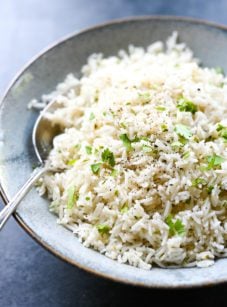
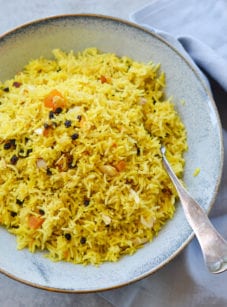

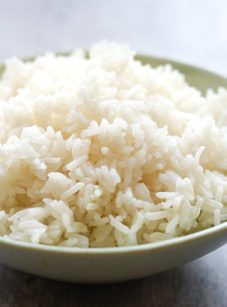
Quickly, I believe there are different rice cookers for medium grain/calrose/sushi rice and basmati/long grain rice. It is my understanding that you can NOT use the same rice cooker for both, unless your rice cooker has a setting for both. Thanks!
Can I make this rice ahead of time? If so, how do you recommend warming it up for serving so it’s still fluffy and tender?
Hi Candy, yes you can make this ahead and reheat in the microwave. Just fluff it with a fork before serving.
Thanks for answering this question! It really helped me with my Indian food project for school!
The amount of water to use is missing from the ingredient list. I know it varies between 1 1/4-2 cups, depending on how firm or soft you would like it.
Fixed! Thank you 🙂
I would like to know how much water and rice I use to make 8 cups of rice?
Hi Joanne, I’d suggest 3 – 3 1/2 cups of uncooked rice and between 4 1/2 – 5 1/4 cups of water. Consult the back of your package as brands vary a bit.
But according to your recipe, you say 1:2…..confusing…..for basmati, ratio is 1: 1.5 or 1:1.75 maximum (rice:water). So 1 cup rice and 1.5 cups water. 1 cups rice :2 cups water will make mush.
Burnt and destroyed all basmati before this (;
Hi Jenn, very nice and simple instructions, you can also try adding few drops of lemon juice. Adding lemon juice helps rice to keep separated from each other. Also, cooked rice stays white after it is cooked and cooled.
Dear Jenn,
What is the water ration to 1 cup of basmati? Is not specify in the recipe. The reason to ask is because on the back of the bag it says 4 cups of water for 1 cup of rice, is this too much water?
Thank you
Hi Sara, The recipe does specify (at the beginning of the 2nd paragraph) that you should use 2 cups of water. 4 cups of water does sound like an awful lot for 1 cup of rice.
If you soak the rice for half an hour before rinsing it will be spectacular.
How would you use a rice cooker for perfect basmati rice?
Mendy, Here’s a link to a good step-by-step:
http://www.wikihow.com/Cook-Rice-in-a-Rice-Cooker
1st Mrs. Jenn let me say that you must be a mind reader because two weeks ago I made basmati rice and it was in a word terrible. My question is can you make basmati rice in a rice steamer or is this type of rice better to make on the stove? Thanks in advance for you help 🙂
Hi Stefan, You can make it on the stovetop or in a rice cooker — it doesn’t make much difference. However, the cooking instructions would be different…for this recipe, go with the stovetop 🙂
Thanks Mrs.Jenn for replying so quickly , I’ll try making the basmati rice again. I’m sure my wife and daughter will want to thank you as well because the last time it was like eating small grains of rocks. Thank you for all the wonderful recipes that you post, I’m a much better cook because of you !!!